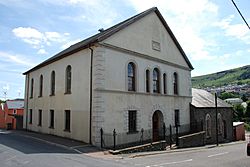Bethania Chapel, Mountain Ash facts for kids
Quick facts for kids Bethania |
|
|---|---|
 |
|
| Country | Wales, United Kingdom |
| Denomination | Independent (Congregationalist) |
| History | |
| Founded | 1850 |
| Architecture | |
| Heritage designation | Grade II listed building |
| Designated | 18 February 1999 |
| Architectural type | Chapel |
| Style | Mid-19th century |
| Completed | 1859 |
Bethania is a historic chapel located on Phillip Street in Mountain Ash, a town in Wales. It is an Independent chapel, which means it governs itself. All of the services held at Bethania are in the Welsh language.
Contents
The History of Bethania Chapel
The story of Bethania began in 1850. At first, it was just a Sunday school for local children. Before that, people met for worship in the home of a man named Daniel Rowlands.
A few years later, in 1854, the community built its first chapel. But soon, it became too small. This was because of a religious movement in 1859 that made many more people in Wales want to attend church.
A New Chapel for a Growing Town
To make room for everyone, a new, larger chapel was built in 1859. It cost £950 and could seat 750 people.
The town of Mountain Ash was also growing quickly at this time. The Deep Duffryn Colliery, a large coal mine, had opened in 1855. This brought many new workers and their families to the area, and many of them joined the chapel.
The chapel building was made even larger in 1887, and a new meeting room called a vestry was added.
Music and Community at Bethania
A very important member of Bethania was a man named David Edward Coleman. He was a talented musician who led the chapel's choir for many years.
In 1872, he was one of the leaders of the South Wales Choral Union. This large choir travelled to Crystal Palace in London and won first prize in a famous singing competition.
The Chapel in Modern Times
Bethania Chapel is still a beautiful and well-cared-for building. It is recognized as a Grade II listed building, which means it is protected for its historical importance.
While the number of members is smaller now, the chapel remains an important part of the community. The Mountain Ash and District Choral Society uses the vestry for its rehearsals, continuing the chapel's long tradition of music.


